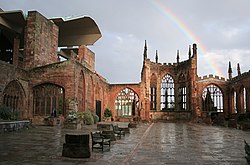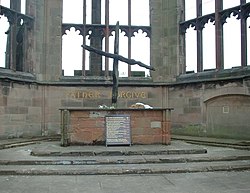Coventry Cathedral
| Coventry Cathedral | |
|
Cathedral Church of St Michael | |
|---|---|
|
Coventry, Warwickshire | |
| Status: | cathedral |
 Coventry new and old cathedrals | |
| Church of England | |
| Diocese of Coventry | |
| Location | |
| Grid reference: | SP335790 |
| Location: | 52°24’30"N, 1°30’25"W |
| History | |
| Modernist | |
| Information | |
| Website: | coventrycathedral.org.uk |
St Michael's Cathedral, more usually Coventry Cathedral, is the seat of the Bishop of Coventry and the Diocese of Coventry. It stands in Coventry in Warwickshire, beside its predecessor, which was gutted by the Luftwafffe during the Blitz.
The city has had three cathedrals. The first was St Mary's, a monastic building, only a few ruins of which remain. The second was St Michael's, a 14th-century Gothic church later designated cathedral, and this was the one which was bombed on 14 November 1940 and remains a ruined shell. The third is the new St Michael's Cathedral, built after the destruction of the former.
St Mary's Priory

The first cathedral in Coventry was St Mary's Priory and Cathedral, 1095 to 1102, when Robert de Limesey moved the bishop's see from Lichfield to Coventry,[1] until 1539 when it was dissolved as part of King Henry VIII's Dissolution of the Monasteries. Prior to 1095, it had been a small Benedictine monastery (endowed by Leofric, Earl of Mercia and Lady Godiva in 1043),[2] Shortly after 1095 rebuilding began and by the middle of the 13th century it was a cathedral of 142 yards in length and included many large outbuildings.[3] Leofric was probably buried within the original Saxon church in Coventry. However, records suggest that Godiva was buried at Evesham Abbey, alongside her father confessor, Prior Aefic.[4]
Old St Michael's Cathedral

St Michael's Church was largely constructed between the late 14th century and early 15th century. It was one of the largest parish churches in the Church of England when, in 1918, it was elevated to cathedral status on the creation of Coventry Diocese.[5] This St Michael's Cathedral now stands ruined, bombed almost to destruction during the Coventry Blitz of 14 November 1940 by the German Luftwaffe. Only the tower, spire, the outer wall and the bronze effigy and tomb of its first bishop, Huyshe Yeatman-Biggs, survived. The ruins of this older cathedral remain hallowed ground and are listed at Grade I.[6] Following the bombing of the mediæval cathedral in 1940, Provost Richard Howard had the words "Father Forgive" inscribed on the wall behind the altar of the ruined building. The spire rises to 295 feet[7] and is the tallest structure in the city. It is also the third tallest cathedral spire in the Church of England: only Salisbury and Norwich cathedrals rise higher.
New St Michael's Cathedral


The current St Michael's Cathedral, built next to the remains of the old, was designed by Basil Spence and Arup, built by John Laing[8] and is a Grade I listed building.[9]
The selection of Spence for the work was a result of a competition held in 1950 to find an architect for the new Coventry Cathedral; his design was chosen from over two hundred submitted.
Spence (later knighted for this work) insisted that instead of re-building the old cathedral it should be kept in ruins as a garden of remembrance and that the new cathedral should be built alongside, the two buildings together effectively forming one church.[10] The use of Hollington sandstone for the new Coventry Cathedral provides an element of unity between the buildings.
The foundation stone of the new cathedral was laid by Elizabeth II on 23 March 1956.[11] The unconventional spire (known as a flèche) is 80 feet tall and was lowered onto the flat roof by a helicopter, flown by Wing Commander John Dowling in April 1962.[12]
The cathedral was consecrated on 25 May 1962, and Benjamin Britten's War Requiem, composed for the occasion, was premiered in the new cathedral on 30 May to mark its consecration.[13][14]
Coventry's modernist design caused much discussion, but on opening to the public it rapidly became a hugely popular symbol of reconciliation in post-war Britain. The interior is notable for its huge tapestry (once thought to be the world's largest) of Christ, designed by Graham Sutherland, the emotive sculpture of the Mater Dolorosa by John Bridgeman in the East end, and the Baptistry window by John Piper, of abstract design that occupies the full height of the bowed baptistery, which comprises 195 panes, ranging from white to deep colours. The stained glass windows in the Nave, by Lawrence Lee, Keith New and Geoffrey Clarke, face away from the congregation. Spence's concept for these Nave windows was that the opposite pairs would represent a pattern of growth from birth to old age, culminating in heavenly glory nearest the altar – one side representing Human, the other side, the Divine. Also worthy of note is the Great West Window known as the Screen of Saints and Angels, engraved directly onto the screen in expressionist style by John Hutton. (Although referred to as the West Window, this is the 'liturgical west' opposite the altar which is traditionally at the east end. In this cathedral the altar is actually at the north end.) The foundation stone, the ten stone panels inset into the walls of the cathedral called the Tablets of the Word, and the baptismal font were designed and carved by the émigré German letter carver Ralph Beyer.

The Charred Cross and the Cross of Nails


The Charred Cross and the Cross of Nails were created after the cathedral was bombed during the Coventry Blitz of the Second World War. The cathedral stonemason, Jock Forbes, saw two wooden beams lying in the shape of a cross and tied them together. A replica of the Charred Cross built in 1964 has replaced the original in the ruins of the old cathedral on an altar of rubble. The original is now kept on the stairs linking the cathedral with St Michael's Hall below.
The Cross of Nails was made of three nails from the roof truss of the old cathedral by Provost Richard Howard of Coventry Cathedral. It was later transferred to the new cathedral, where it sits in the centre of the altar cross. It has become a symbol of peace and reconciliation across the world. There are over 160 Cross of Nails Centres all over the world, all of them bearing a cross made of three nails from the ruins, similar to the original one. They are co-ordinated by the International Centre for Reconciliation.
One of the crosses made of nails from the old cathedral was donated to the Kaiser Wilhelm Memorial Church in Berlin, which was destroyed by Allied bombing and is also kept as a ruin alongside a newer building. A replica of the cross of nails was also donated to the Chapel of Reconciliation (Kapelle der Versöhnung) which forms part of the Berlin Wall Memorial. A copy of the Stalingrad Madonna by Kurt Reuber that was drawn in 1942 in Stalingrad (now Volgograd) is shown in the cathedrals of all three cities (Berlin, Coventry and Volgograd) as a sign of the reconciliation of the three countries that were once enemies.
A mediæval cross of nails has also been carried on board all British warships who subsequently bear the name HMS Coventry:[15] that aboard the Coventry sunk by enemy action in the Falklands War was salvaged by Royal Navy divers, and presented to Coventry Cathedral by the ship's Captain and colleagues.[16] It cross was subsequently presented first to the next HMS Coventry in 1988 until she was decommissioned in 2002, and then to HMS Diamond, which is affiliated to Coventry, during her commissioning ceremony on 6 May 2011 by Captain David Hart-Dyke, the commanding officer of Coventry when she was sunk.[17]
Gallery
- Coventry Cathedral
-
Winston Churchill visiting the ruins of the old cathedral in 1941.
-
The surviving tower and steeple, which functions as a working bell tower.
-
Effigy and tomb of Huyshe Yeatman-Biggs, first Bishop of Coventry.
-
Josefina de Vasconcellos' statue Reconciliation in the old cathedral's nave.
-
The baptistry window by John Piper from inside the cathedral.
-
The font, a boulder from Bethlehem.
-
The top of spire of the new cathedral.
-
Graham Sutherland tapestry.
-
Chapel of Christ in Gethsemane.
In popular culture
- To Say Nothing of the Dog (1997), a Hugo Award-winning novel by Connie Willis, centres on an effort to rebuild the second cathedral in 2057.
- The Facts of Life (2002), a Grand Prix de l'Imaginaire and World Fantasy Award-winning novel by Graham Joyce, following the lives of Martha Vine and her seven daughters in Coventry (where Joyce was born) in the years during and immediately following the Second World War.
- Nativity! (2009), the film's final sequences were filmed in the old cathedral's grounds.
Outside links
| ("Wikimedia Commons" has material about Coventry Cathedral) |
- Coventry Cathedral
- Historic Coventry: Coventry's three cathedrals
- Virtual tour of both the new cathedral and the ruins
- The Cross of Nails
- Flickr images tagged Coventry Cathedral
- Details of the organ from the National Pipe Organ Register
- Photograph of interior prior to destruction
- Article about the cathedral's mediæval stained glass [1]
References
- ↑ Nicolas, Nicholas Harris (1825). A synopsis of the peerage of England: exhibiting, under alphabetical arrangement, the date of creation, descent and present state of every title of peerage which has existed in this country since the conquest... J. Nichols and son. p. 862.
- ↑ Page, William (1908). The City of Coventry: Churches: Introduction - A History of the County of Warwick: Volume 8: The City of Coventry and Borough of Warwick.
- ↑ Vail, Anne (2004). Shrines of Our Lady in England. Gracewing Publishing. p. 56.
- ↑ McGrory, David (2003). A history of Coventry. Phillimore. p. 17.
- ↑ Pepin, David (2004). Discovering Cathedrals. Osprey Publishing. p. 58.
- ↑ National Heritage List 1076651: Ruined Cathedral Church of St Michael, Coventry
- ↑ Demidowicz, George (2003). Buildings of Coventry: an illustrated architectural history. Stroud: Tempus. pp. 28. ISBN 0752431153.
- ↑ National Gallery of Scotland
- ↑ National Heritage List 1342941: Cathedral of St Michael, Coventry
- ↑ Mansell, George (1979). Anatomy of architecture. A & W Publishers. p. 178.
- ↑ Thomas, John (1987). Coventry Cathedral. Unwin Hyman. p. 129.
- ↑ "Wing Commander John Dowling". The Telegraph. 28 July 2000. http://www.telegraph.co.uk/news/obituaries/1350613/Wing-Commander-John-Dowling.html. Retrieved 31 March 2012.
- ↑ Havighurst, Alfred F. (1985). Britain in Transition: The Twentieth Century. University of Chicago Press. p. 643.
- ↑ Roncace, Mark; Gray, Patrick (2007). Teaching the Bible Through Popular Culture and the Arts. Society of Biblical Lit. p. 60.
- ↑ The Cross of Nails Society. h2g2
- ↑ The Army quarterly and defence journal, Volume 113. West of England Press. p. 229.
- ↑ "Navy’s newest ship will carry a poignant reminder of the past". Portsmouth News. 7 May 2011. http://www.portsmouth.co.uk/news/local/east-hampshire/navy_s_newest_ship_will_carry_a_poignant_reminder_of_the_past_1_2659444. Retrieved 7 May 2011.
| Cathedrals of the Church of England |
|---|
|
Province of York:
Blackburn •
Bradford •
Carlisle •
Chester •
Durham •
Liverpool •
Manchester •
Newcastle upon Tyne •
Peel •
Ripon •
Sheffield •
Southwell •
Wakefield •
York
|








